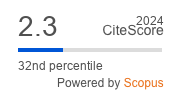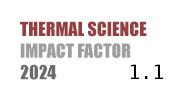THERMAL SCIENCE
International Scientific Journal
THE 3-D ANALYSIS OF CU-WATER NANOFLUID INFLUENCE ON THERMAL AND HYDRAULIC PERFORMANCE IN A 30° BAFFLED COUNTERFLOW HEAT EXCHANGER
ABSTRACT
This study numerically analyzes a baffled counterflow heat exchanger with two adjacent side-by-side rectangular channels separated by a thin aluminum wall, allowing conductive heat transfer without fluid mixing. The hot channel carries water, while the cold Cu-water nanofluid-flows in the opposite direction. Transversal baffles, fixed in place at a 30° rotation angle, are employed to enhance thermal performance by promoting secondary flows and disrupting boundary-layers. Using the finite element method, the effects of Reynolds number (500-2000) and nanoparticle volume fraction (0%-4%) on flow structure, heat transfer, and pressure drop are investigated. Results show that increasing the nanoparticle concentration and flow rate improves thermal gradients and mixing intensity in both channels. Despite a moderate increase in pressure drop, the system achieves a maximum thermal efficiency of 35.75% under conditions of high nanoparticle concentration and low Reynolds number, confirming the effectiveness of combining nanofluids and geometric modifications for enhancing thermal performance in compact systems.
KEYWORDS
PAPER SUBMITTED: 2025-03-02
PAPER REVISED: 2025-05-27
PAPER ACCEPTED: 2025-06-29
PUBLISHED ONLINE: 2025-09-26
THERMAL SCIENCE YEAR
2025, VOLUME
29, ISSUE
Issue 4, PAGES [3131 - 3138]
- Medjahed, et al. Details on the Hydrothermal Characteristics Within a Solar-Channel Heat-Exchanger Provided with Staggered t-Shaped Baffles, Energies, 14 (2021). 20, 6698
- Abidi, A., Sajadi, S. M. (2023). Numerical assessment of hydraulic behavior and thermal efficiency of multi-phase hybrid nanofluid in a shell-and-tube heat exchanger with inclined baffles. Engineering Analysis with Boundary Elements, 156 (2021), Nov., pp. 114-125
- Tavakoli, M., Soufivand, M. R., Performance Evaluation Criteria and Entropy Generation of Hybrid Nanofluid in a Shell-and-Tube Heat Exchanger with two Different Types of Cross-Sectional Baffles, Engineering Analysis with Boundary Elements, 150 (2023), May, pp. 272-284
- Al-Saad, et al., The Ag and Al2O3/Water Two-Phase Transient Flow Analysis in a Double-Pipe Heat Exchanger Equipped With Baffles And Rotating Inner Tube, Case Studies in Chemical and Environmental Engineering, 11 (2025), 101117
- Bahiraei, M., et al., Thermal-Hydraulic Performance of a Nanofluid pn a Shell-and-Tube Heat Exchanger Equipped with New Trapezoidal Inclined Baffles: Nanoparticle shape effect, Powder Technology, 395 (2022), Jan., pp. 348-359
- Ahamed, R., et al., Thermal-Hydraulic Performance and Flow Phenomenon Evaluation of a Curved Trapezoidal Corrugated Channel with E-Shaped Baffles Implementing Hybrid Nanofluid, Heliyon, 10 (2024), 7, e28698
- Rajhi, W., et al., Synergistic Effect of Outer Helical Fins and Hybrid Nanofluid on Hydrothermal Performance of Shell and Two-Coil Heat Exchanger, Case Studies in Thermal Engineering, 72 (2025), 106238
- Gholizadeh, A., et al., The Role of Nanofluids and Fins in a Heat Exchanger on Waste Energy Recovery from a Diesel Engine: An Experimental and Numerical Study, Energy Reports, 8 (2022), Nov., pp. 13353-13368
- Jalili, B., et al., Novel Usage of the Curved Rectangular Fin on the Heat Transfer of a Double-Pipe Heat Exchanger with a Nanofluid, Case Studies in Thermal Engineering, 35 (2022), 102086
- Wang, et al., Two-Phase Simulation and Environmental Consideration of Thermo-Hydraulic Behavior and Entropy Production of Water/TiO2-SWCNT Hybrid Nanofluid in a U-Shaped Heat Exchanger Equipped with Needle Fins of Different Sizes, Engineering Analysis with Boundary Elements, 146 (2023), 1, pp. 928-938
- Tahrour, et al., The 3-D Numerical Study and Comparison of Thermal-Flow Performance of Various Annular Finned-Tube Designs, Journal of Ocean Engineering and Science, 8 (2023), 3, pp. 294-307
- Maatki, C., Kriaa, K., Heat Transfer Analysis for Cooling Discrete Heat Source in Micro-Channel Equipped with Flexible Baffles Using Al2O3-Cu/Water Hybrid Nanofluid, Case Studies in Thermal Engineering, 71 (2025), 106241
- Fereidooni, J., Baffles' Size Impact on the Heat Transfer and Second Law Features of Magnetic Hybrid Nanofluid Within a Hexagonal-Shaped Porous Domain, Journal of Magnetism and Magnetic Materials, 582 (2023), 171037
- Bouzennada, T., et al., Numerical Study on Nanofluid Heat Transfer and Fluid-Flow Within a Micro-Channel Equipped with an Elastic Baffle, Case Studies in Thermal Engineering, 56 (2024), 104247
- Bahiraei, M., Monavari, A., Irreversibility Characteristics of a Mini Shell and Tube Heat Exchanger Operating with a Nanofluid Considering Effects of Fins and Nanoparticle Shape, Powder Technology, 398 (2022), 117117
- Hammid, S., et al., Laminar Rarefied Flow Analysis in a Micro-Channel with H2O-Cu Nanofluid: A Thermal lattice Boltzmann Study, Modern Physics Letters B, 38 (2024), 03, 2450006
- Aghaei, A., Thermal-Hydraulic Analysis of Syltherm 800 Thermal Oil/γ-AlOOH Nanofluid in a Baffled Shell and Tube Heat Exchanger Equipped with Corrugated Helical Tube with Two-Phase Approach, Engineering Analysis with Boundary Elements, 146 (2023), Jan., pp. 668-694
- Menni, Y., et al., Computational Fluid Dynamics Based Numerical Simulation of Thermal and Thermo-Hydraulic Performance of a Solar Air Heater Channel Having Various Ribs on Absorber Plates, Mathematical Modelling of Engineering Problems, 6 (2019), 2, pp. 170-174
- Punia, A., Ray, R. K., Higher-Order Super-Compact Scheme for 3-D Heat Transfer with Nanofluid and Conducting Fins, Journal of Molecular Liquids, 426 (2025), 127253
- Ameur, H., et al., Enhancement of the Cooling of Shear-Thinning Fluids in Channel Heat Exchangers by Using the V-Baffling Technique, Thermal Science and Engineering Progress, 18 (2020), 100534
- Hissouf, M., et al., Numerical Study of a Covered Photovoltaic-Thermal Collector (PVT) Enhancement Using Nanofluids, Solar Energy, 199 (2020), Mar., pp. 115-127
- Brinkman, H. C., The Viscosity of Concentrated Suspensions and Solutions, Journal of Chemical Physics, 20 (1952), 4, pp. 571-571
- Hamilton, R. L., Crosser, O. K., Thermal Conductivity of Heterogeneous Two-Component Systems, Industrial & Engineering Chemistry Fundamentals, 1 (1962), 3, pp. 187-191
- Laskowski, R., The Black Box Model of a Double-Tube Counter-Flow Heat Exchanger, Heat and Mass Transfer, 51 (2015), Dec., pp. 1111-1119

